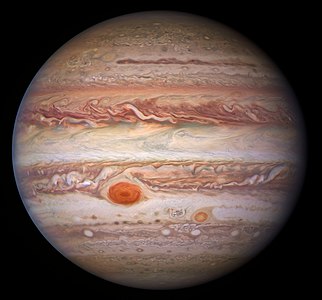The fifth planet from the Sun and the most massive in our Solar System, Jupiter is a gas giant. Its mass exceeds that of all other planets in the Solar System combined, and it is just slightly less than one one-thousandth of the Sun’s mass.

Gravity: 24.79 m/s²
Radius: 69,911 km
Length of day: 0d 9h 56m
Distance from Sun: 778.5 million km
Mass: 1.898 × 10^27 kg (317.8 M⊕)
Coordinates: RA 2h 30m 22s | Dec +13° 49′ 3″
Moons: Europa, Io, Ganymede, Callisto, Amalthea, Jupiter LXI, MORE
Jupiter travels around the Sun from a distance of 5.20 astronomical units (778.5 gigameters) and completes one orbit every 11.86 years. Ranking as the third most luminous celestial body in Earth’s night sky, following the Moon and Venus, Jupiter has been observed since ancient times and derives its name from the chief deity of the ancient Roman religion, Jupiter.
Orbit and Rotation
Jupiter boasts the solar system’s shortest day, completing a full rotation in approximately 10 hours. In terms of its orbital journey around the Sun, referred to as a Jovian year, Jupiter accomplishes this in about 12 Earth years or 4,333 Earth days. Notably, Jupiter’s equator is tilted merely 3 degrees concerning its orbital plane, resulting in a nearly upright spin and milder seasonal variations compared to other planets.
Moons
Jupiter comprises a miniature solar system with four prominent moons and numerous smaller ones!
Officially recognized by the International Astronomical Union, Jupiter has a total of 95 moons. First observed by astronomer Galileo Galilei in 1610 using an early telescope model, the four largest moons—Io, Europa, Ganymede, and Callisto—known as the Galilean satellites, continue to captivate with their unique features. Among them, Io stands out as the most volcanically active celestial body, while Ganymede holds the title of the largest moon in the entire solar system, surpassing even the planet Mercury in size. Callisto, displaying minimal craters, hints at a modest level of ongoing surface activity. Furthermore, Europa, concealing a potential liquid-water ocean beneath its frozen crust, has become the focus of NASA’s Europa Clipper mission scheduled for launch in 2024, aiming to explore the ingredients for life.
Rings
Unveiled in 1979 through the observations of NASA’s Voyager 1 spacecraft, Jupiter’s rings emerged as an unexpected surprise! Comprised of small, dark particles, these rings are challenging to discern unless illuminated from behind by the Sun. Insights from the Galileo spacecraft suggest that the ring system of Jupiter might originate from dust particles generated when interplanetary meteoroids collide with the smaller moons situated closest to the giant planet.
Surface
Being a gas giant, Jupiter lacks a distinct solid surface and is predominantly composed of swirling gases and liquids. While there is no place for a spacecraft to land on Jupiter, attempting to traverse its atmosphere poses formidable challenges. The profound pressures and extreme temperatures deep within the planet can crush, melt, and vaporize any spacecraft endeavoring to navigate through its turbulent layers.
The Great Red Spot
The Earth’s most colossal hurricanes, spanning over 1,000 miles with winds gusting up to 200 mph, can extend across nearly all U.S. states east of Texas. However, even these immense storms are overshadowed by Jupiter’s Great Red Spot, a colossal storm twice as wide as Earth. With turbulent winds reaching speeds of approximately 400 mph, this enormous storm has been raging across Jupiter’s skies for the past 150 years, and possibly much longer. Although observers have noticed a prominent spot on Jupiter since the 1600s, it remains uncertain whether they were witnessing a distinct storm. Presently, scientists acknowledge the presence of the Great Red Spot, yet unraveling the mysteries behind its swirling reddish hues continues to pose a significant challenge.
Observations of the Great Red Spot date back to the 1600s when early astronomers, armed with telescopes, first turned their gaze toward Jupiter. Despite centuries of study, certain aspects of the storm, such as the mechanisms driving its longevity and the precise causes of its coloration, continue to elude scientists. The Juno spacecraft, which has been studying Jupiter since 2016, provides valuable data that contributes to a deeper understanding of this enigmatic and colossal storm. The Great Red Spot stands as a testament to the dynamic and complex nature of Jupiter’s atmosphere, offering a mesmerizing spectacle in our solar system.
https://science.nasa.gov/jupiter/facts/
https://www.britannica.com/place/Great-Red-Spot
https://en.wikipedia.org/wiki/Jupiter